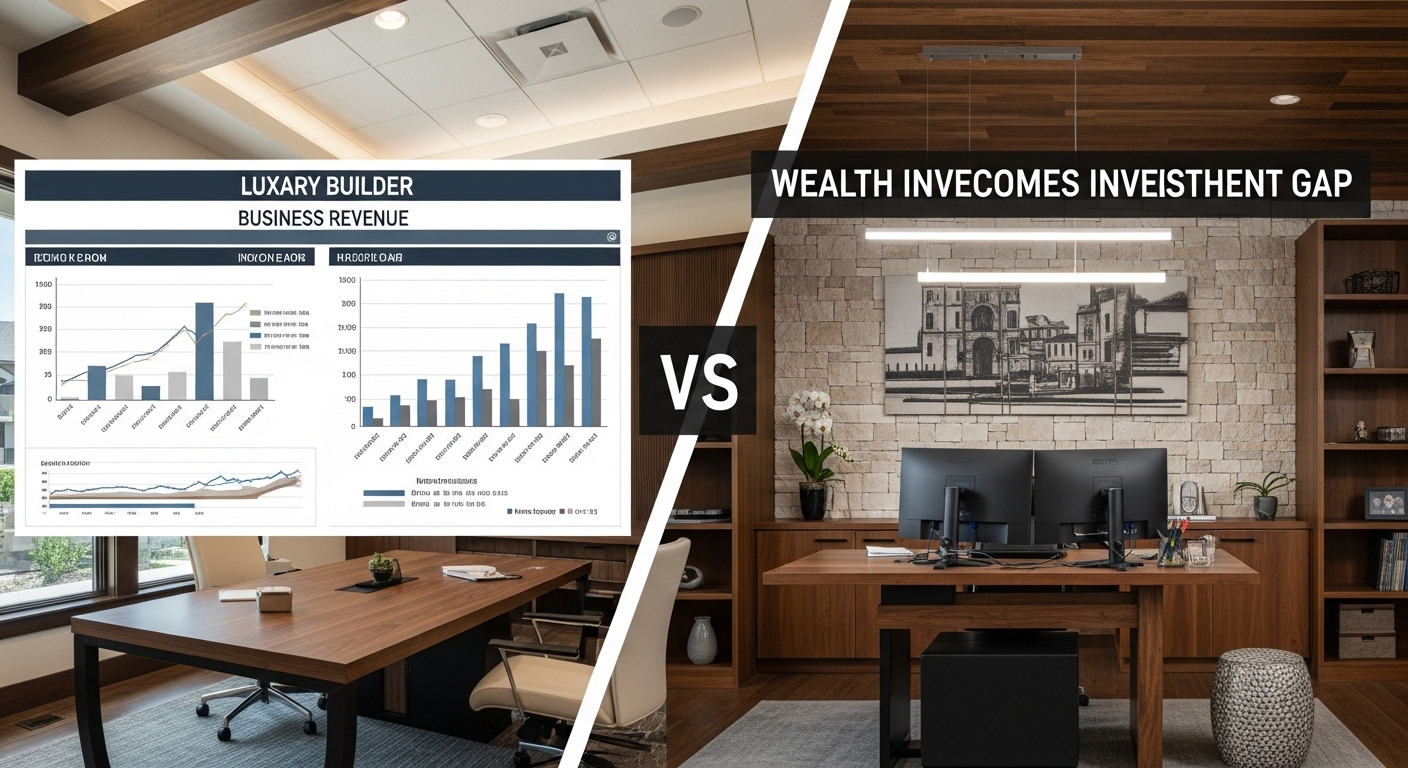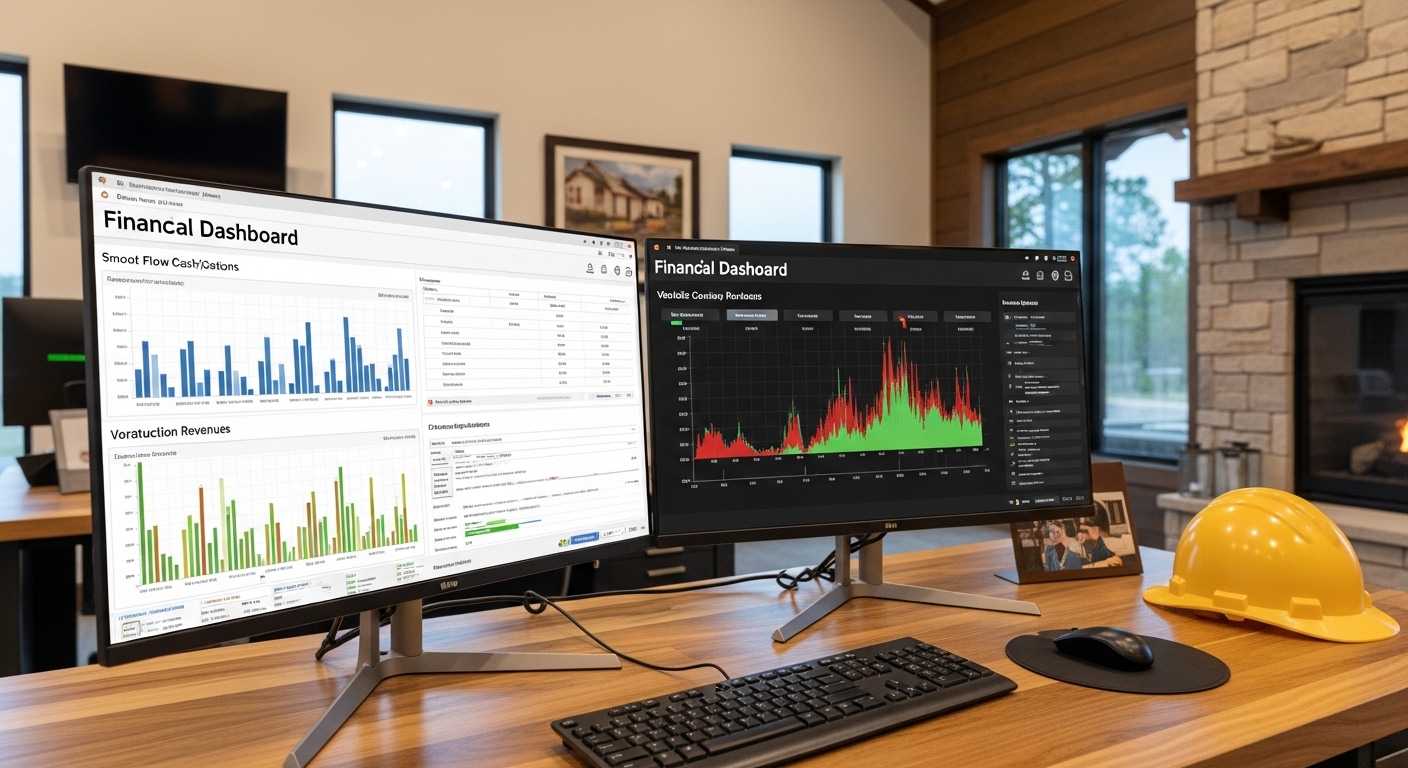July 31, 2025 by 100XBuilds Team
Personal Wealth Strategies for High-Earning Builders

"The average custom home builder earning $5M+ annually accumulates only 12% of their revenue as personal wealth, while strategic wealth builders capture 28-35%." - Private Wealth Management Study, 2024
You've built a thriving luxury construction empire. Your projects command seven-figure price tags, your reputation opens doors across exclusive communities, and your annual revenue consistently exceeds $5 million. Yet here's the uncomfortable truth: most successful builders remain surprisingly cash-poor despite generating substantial revenue.
The difference between builders who retire comfortably and those who work until they can't? A systematic approach to personal wealth management that treats your financial future with the same precision you apply to custom home construction.
The Builder's Wealth Paradox: Why Success Doesn't Equal Security

Your business generates impressive cash flow, but three critical factors create a wealth accumulation bottleneck:
Cash flow timing misalignment: Project payments arrive in large, irregular chunks while personal expenses remain constant monthly obligations.
Asset concentration risk: 85% of your net worth likely sits in business assets, equipment, and real estate inventory rather than diversified investments.
Tax inefficiency: Without strategic planning, builders typically surrender 35-42% of profits to taxes versus the 18-24% achieved through proper wealth structuring.
Consider this real scenario: A Texas builder generating $8.2M annually discovered he'd accumulated only $1.1M in liquid assets after 15 years of operation. Through strategic restructuring, he now captures $2.8M annually in personal wealth while maintaining identical business operations.
Strategic Asset Allocation: The Builder's Portfolio Framework

Traditional investment advice fails builders because it ignores your unique cash flow patterns and risk profile. Here's the strategic framework that works:
Core Holdings (40-50% of liquid assets)
Real estate investment trusts (REITs): Focus on commercial and luxury residential REITs that align with your market expertise. Target 8-12% annual returns while maintaining liquidity.
Blue-chip dividend stocks: Companies with 20+ year dividend growth records provide steady income during project gaps. Aim for 4-6% dividend yields.
Municipal bonds: Tax-free income particularly valuable for high-earning builders. Focus on AAA-rated bonds from your operating markets.
Growth Investments (25-35% allocation)
Technology sector exposure: Through low-cost index funds rather than individual stock picking. Target 10-15% annual growth over 10+ year periods.
International diversification: 15-20% allocation to developed international markets reduces correlation with U.S. construction cycles.
Alternative investments: Private equity real estate funds, opportunity zone investments, and qualified small business stock for tax advantages.
Liquidity Reserve (15-25% allocation)
High-yield savings: 6-12 months of personal expenses in immediately accessible accounts earning 4-5% annually.
Short-term CDs: Ladder maturities to match known major expenses (equipment purchases, tax payments).
Money market funds: For project deposit requirements and unexpected opportunities.
Tax Optimization: Keeping More of What You Earn

Strategic tax planning can save builders $200,000-$500,000 annually. Here are the highest-impact strategies:
Business Structure Optimization
S-Corporation election: Reduces self-employment taxes on profits above reasonable salary levels. Typical savings: $15,000-$35,000 annually.
Cost segregation studies: Accelerate depreciation on completed spec homes and office buildings. Average first-year tax savings: $75,000-$150,000.
Section 199A deduction: Claim up to 20% deduction on qualified business income through proper entity structuring and W-2 wage management.
Advanced Strategies
Defined benefit pension plans: Contribute $200,000+ annually while reducing current taxes. Particularly effective for builders with few employees.
Captive insurance companies: Self-insure business risks while building tax-deferred wealth. Minimum annual premiums: $1.2M.
Opportunity zone investments: Defer and potentially eliminate capital gains taxes through qualified investments in designated zones.
Estate Planning: Protecting Generational Wealth

Your construction business represents significant value that requires sophisticated transfer strategies:
Business Succession Planning
Grantor retained annuity trusts (GRATs): Transfer business growth to heirs while retaining income stream. Particularly effective during business expansion phases.
Family limited partnerships: Maintain control while transferring ownership interests at discounted valuations. Typical discounts: 25-40%.
Employee stock ownership plans (ESOPs): Sell to employees while deferring capital gains taxes and maintaining involvement.
Personal Estate Strategies
Irrevocable life insurance trusts: Remove life insurance from taxable estate while providing liquidity for estate taxes and business buyouts.
Charitable remainder trusts: Convert appreciated assets to income stream while reducing estate taxes and supporting causes you value.
Dynasty trusts: Protect wealth from estate taxes across multiple generations while maintaining family control.
Cash Flow Management: Smoothing the Revenue Rollercoaster

Irregular project payments create personal financial stress despite business success. Implement these systems:
Revenue Smoothing Strategies
Escrow account system: Deposit 25-30% of each project payment into dedicated personal wealth account before any business or personal spending.
Quarterly wealth transfers: Move fixed amounts from business to personal accounts regardless of project timing. Treat as non-negotiable expense.
Performance bonus structure: Pay yourself bonuses tied to annual profit targets rather than project completion timing.
Emergency Fund Sizing
12-month expense coverage: Higher than typical recommendations due to construction industry volatility.
Project gap reserves: Additional 6-month buffer for extended periods between major projects.
Opportunity funds: Liquid capital for time-sensitive investment opportunities or business expansion.
Investment Property Strategy: Leveraging Your Expertise

Your construction knowledge provides significant advantages in real estate investing:
Direct Property Investment
Luxury rental properties: Focus on markets where you build. Your reputation and relationships provide deal flow and management advantages.
Fix-and-flip opportunities: Leverage construction expertise for higher margins. Target 25-35% returns on invested capital.
Commercial real estate: Office buildings, retail centers, and industrial properties in your operating markets.
Indirect Real Estate Exposure
Real estate syndications: Passive investment in larger commercial projects. Typical returns: 12-18% annually.
Real estate crowdfunding: Diversified exposure to markets beyond your geographic area. Minimum investments: $25,000-$100,000.
Public REITs: Liquid exposure to real estate sectors outside your expertise (healthcare, data centers, logistics).
Retirement Planning: Building Your Exit Strategy

Most builders work longer than necessary because they haven't quantified their retirement needs or optimized their savings strategies:
Retirement Income Targeting
Replacement ratio calculation: Target 70-80% of current income from investment returns and business sale proceeds.
Healthcare cost planning: Budget $300,000-$500,000 for lifetime healthcare expenses beyond Medicare coverage.
Lifestyle inflation protection: Account for continued luxury lifestyle preferences in retirement spending projections.
Business Exit Strategies
Strategic buyer preparation: Document systems and processes to maximize business value for acquisition.
Management buyout structuring: Seller financing arrangements that provide ongoing income while transferring ownership.
Gradual transition planning: Reduce involvement over 3-5 years while maintaining income and business value.
Risk Management: Protecting Your Wealth

Wealth protection requires sophisticated insurance and legal strategies:
Personal Insurance Portfolio
Umbrella liability coverage: Minimum $5-10 million coverage given your high net worth and business exposure.
Disability insurance: Replace 60-70% of income if unable to work. Particularly critical for hands-on builders.
Key person life insurance: Protect family and business partners from income loss due to your death.
Asset Protection Strategies
Domestic asset protection trusts: Shield assets from creditors while maintaining some access and control.
LLC structures: Separate investment properties and business assets into distinct legal entities.
Homestead exemptions: Maximize primary residence protection through proper state law utilization.
Implementation Timeline: Your 90-Day Wealth Action Plan

Transform your wealth management approach through systematic implementation:
Days 1-30: Foundation Building
Week 1: Complete comprehensive financial audit including all assets, liabilities, and cash flows.
Week 2: Engage qualified fee-only financial advisor with construction industry experience.
Week 3: Optimize business structure for tax efficiency and wealth transfer.
Week 4: Establish automated wealth transfer systems from business to personal accounts.
Days 31-60: Strategy Implementation
Week 5-6: Open and fund diversified investment accounts according to strategic allocation framework.
Week 7: Implement advanced tax strategies including retirement plan optimization and estate planning basics.
Week 8: Establish comprehensive insurance coverage and asset protection structures.
Days 61-90: System Optimization
Week 9-10: Fine-tune investment allocations based on risk tolerance and timeline assessment.
Week 11: Create detailed estate planning documents and business succession framework.
Week 12: Establish quarterly review schedule and performance monitoring systems.
Measuring Success: Key Performance Indicators
Track these metrics to ensure your wealth management strategy delivers results:
Personal savings rate: Target 25-35% of after-tax income flowing to investments and wealth building.
Net worth growth: Aim for 15-20% annual increases through combined business growth and investment returns.
Liquidity ratio: Maintain 12-18 months of expenses in readily accessible accounts.
Asset diversification: Limit business assets to 60% or less of total net worth within 5 years.
Your construction expertise built a successful business. Now apply that same systematic approach to building personal wealth that will support your family for generations. The builders who thrive in retirement started implementing these strategies during their peak earning years—not after.
Ready to transform your financial future with the same precision you bring to luxury construction? Schedule a comprehensive wealth assessment with our specialized team of advisors who understand the unique challenges and opportunities facing successful custom home builders.
[Contact 100XBuilds today to connect with wealth management professionals who specialize in construction industry success stories.]
